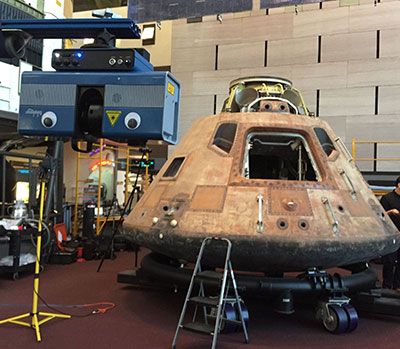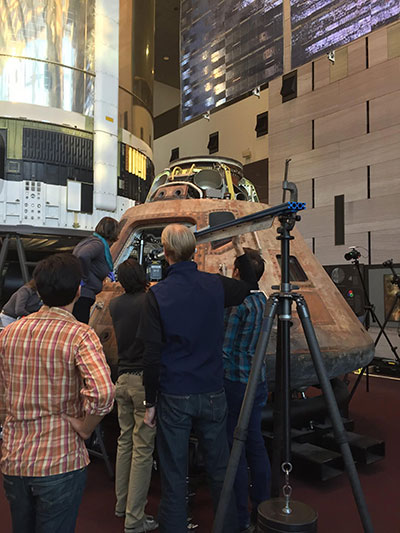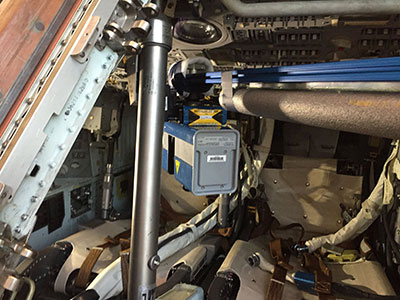 Space News space history and artifacts articles Messages space history discussion forums Sightings worldwide astronaut appearances Resources selected space history documents |
If you have previously registered, but forgotten your password, click here.
| ||||||||
| Robert Pearlman | Smithsonian X 3D was first announced in November 2013: The Smithsonian is a leader in using 3-D technology to make museum collections and scientific specimens more widely available for anyone to use and study. The Smithsonian X 3D explorer and the initial objects we scanned are the first step in showing how this technology will transform the work of the Smithsonian and other museums and research institutions.As Günter Waibel, director of the Digitization Program Office, explains, they have their work cut out for them. The Smithsonian digitization challenge and opportunity can be measured by the total number of collection items: at 137 million objects, artworks and specimens, capturing the entire collection at a rate of 1 item per minute would take over 260 years of 24/7 effort. At the present moment, the Smithsonian has prioritized the digitization of about 10% of its collections for digitization.To date, the 3D objects presented online do not include space artifacts, but there is one item from the National Air and Space Museum: the 1903 Wright Flyer. | |||||||
| SpaceAholic | It will also be possible to render the scanned objects in solid 3D form at home if you have the appropriate 3D printer technology. The handheld 3D scanner being used by the Smithsonian is the FARO EDGE ScanArm ES ...as the price drops we collector's should also be able to 3D catalog our collections for the online public. | |||||||
| Robert Pearlman | MakerBot markets a digitizer for $799, though it is primarily focused on 3D printing rather than virtual models. | |||||||
| space1 | You can also use 3D scanning services such as from 3D Engineering Solutions in Cincinnati, Ohio. I went to them in 2010 to scan an Apollo Rotation Control grip in my collection. I use that model to create Apollo control handle displays. The technology typically requires some manual post-scanning processing. As the technology advances it should become more plug and play. | |||||||
| Robert Pearlman | National Air and Space Museum update We can't take you to the Moon and back, but with the help of our friends at Smithsonian 3D Digitization, you'll be able to take a virtual tour of the Apollo 11 Command Module "Columbia." Stop by our Museum in Washington, DC through Thursday to watch them in action and look for the 3D tour online next summer.  | |||||||
| Robert Pearlman | collectSPACE Smithsonian reveals Apollo 11 3D model | |||||||
| Fra Mauro | Stunning! Wow! It is almost like being in Columbia. | |||||||
| jklier | This is really stunning! I do wonder why they did not scan at a resolution high enough to read the text on the button/switch labels? Perhaps they did and just have not released it yet? Being able to read the labels would increase the level of interest for me x100. | |||||||
| p51 | That's the primary problem with stuff like this, it becomes out of date too fast... | |||||||
| Robert Pearlman | The scan was conducted using state-of-the-art technology. According to the curators, the reason why the full-resolution files are not accessible online is that they take up more than a terabyte of compressed data. All together, it is simply too large a model for the bandwidth and computing power of the average user. The full-resolution scans are, at least for now, only accessible by the curators at the museum. That said, there are areas in the online model where you can click to see some of the highlights in better detail. | |||||||
| aneedell | Also, try the Google Cardboard version. On a good HD monitor all five 360 degree spherical images (on a computer you have to change the trailing number in the link address to access additional views) show much more detail. ------------------ | |||||||
| fredtrav | Thanks for that link Allan. It is stunning work. I feel like I am inside. | |||||||
| p51 | quote:Yeah, but that state changes. Ask any library that made microfilm of all those newspapers in their collections, then threw out the originals. Now, they all deeply regret this as they no longer have any good representations of the original material. YES, I know that this isn't the same thing, but I always roll my eyes when someone suggests that whatever they used to record something will be all anyone in the future will need. Someday, this scan will look as crude as a crayon drawing, compared to whatever is being used by then. | |||||||
| aneedell | Rest assured, we won't be throwing out Columbia. | |||||||
| jklier | Robert- thanks for confirming the quality of the scans. I'm happy to hear it was captured in such detail. Alan - Thank you for the link! That brings it up to a new level of enjoyment! | |||||||
| jklier | Now we need a version that has working flippable switches. I want to a try an SCE to Aux! | |||||||


